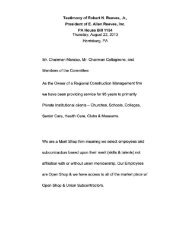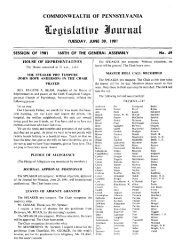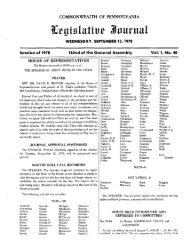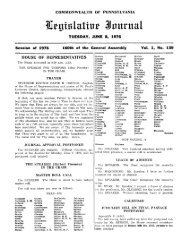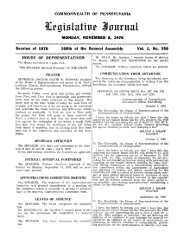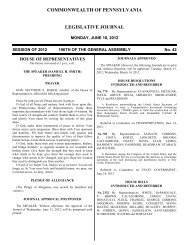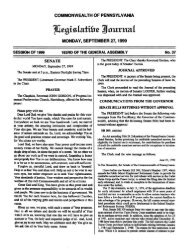Statement of Ronald B. Herberman, MD Chairman of Board ...
Statement of Ronald B. Herberman, MD Chairman of Board ...
Statement of Ronald B. Herberman, MD Chairman of Board ...
You also want an ePaper? Increase the reach of your titles
YUMPU automatically turns print PDFs into web optimized ePapers that Google loves.
complement epidetniological studies so that data f~om<br />
these two sources can be cross-referenced m reveal<br />
important assouattons. For example short term epidemiological<br />
data that tncludes intense exposures might be<br />
related to in vitro and in viva experiments that screen for<br />
the cell and tisue effects <strong>of</strong> short term, Intense exposures<br />
Moreover, studies involving humans, head phantoms, cell<br />
cultures and antmal models may be integrated to provide a<br />
mechanistic understanding <strong>of</strong> events associated w~th ipsilateral<br />
and convalateral exposures and nsks, as this is<br />
currently poorly understood and problemdtic.<br />
Published repons suggest that mammalian brain tissue<br />
may be sensittve to cell phone levels <strong>of</strong> EMF and exhibit<br />
measurable changes in structutE md function [5, 17-21 1.<br />
For example there u evidence whlch sllows that certain<br />
enLymus and DNA can be directly damaged by lowintensity<br />
EMFs, although mote canfirtnatory work needs to<br />
be done and the precise mechanism(s) <strong>of</strong> damage has to be<br />
elucidated [5, 17, IS, 211. The work <strong>of</strong> Volkow el al. [lq<br />
w~th human subjects shows that cell phone use at lower<br />
than typtcal energy levels can cause psil lateral Increases in<br />
bran glucose metaboltsm This acute physiolagicai finding<br />
Indicates chat biological effects can be caused by exposure<br />
to cell photle EMF, and it is reasonable to conclude that<br />
further tn vltro and in vivo studies to elucidate potential<br />
mecltanistns <strong>of</strong> lrrological damage are warranted [211<br />
Conclusions<br />
Edwards BK (ads) SEER Cancer Sta~ixtics Review, 1975-2002,<br />
National Cancer Instirure. Bcrhesda. <strong>MD</strong>, htrp:/!scc~.caacer.gov!<br />
cudi975_20M/, based on November 2W6 S m darn submission,<br />
posted m the SEER Web site, 2007<br />
2. Pwes J (2010) One canclusion emerges from Interphone smdy:<br />
conrmversy will continue, I Natl Cancer lmt 102(13):928-931<br />
3. (2010) CBTRUS statistical repon: primary brain .and centrzl<br />
nervous system tumors diagnosed in the United States in<br />
2004-2006. Central Brain Tomor Registry <strong>of</strong> the United States.<br />
Hirisdale<br />
4. Bonnin JM, Rubinstein LI 11989) A8rrubTastomasa pathologicat<br />
study <strong>of</strong> 23 tomors, with a post-operative foliaw-op in 13<br />
patients. Neurosurgery 25(1):6-13<br />
5. Khurvila VG, Teo C, Kundi M. Hardell L, Cilrkrg M (2009)<br />
Cell phones and bnin tumors! u review including the long-term<br />
epidemiologic dam. Surg New1 72(3):205-214 (discussion<br />
214215)<br />
6. Christ A, Gosselin MC, Christopoulou M, Kuhn S, Kuster N<br />
(2010) Age.dependeut tissue-specific exposure <strong>of</strong> ceil phonc<br />
usen. Phys Med Bioi 55(7):L767-1783<br />
7. Lenhae A, Ling R, Catnpbcli SW, Furcell K [ZOIO, Apiil) Teens<br />
and mobile phones. A project <strong>of</strong> the Pew Ramirrch Center and the<br />
University <strong>of</strong> Michipn. Aveilable at http:i/www.pewintcrneior&'<br />
Repom!201O~ems-;md-M(1biie~Phones.~spx<br />
8. Knamtsch P. SpixC, lung I, BiettoorM (2008) Childhoodl=ukcmia<br />
In the vicinity <strong>of</strong> nuclear power planrs in Germany. Dlsch Arztchl<br />
lnt 105:725-732<br />
9. Gladson Ch Pr;lyson RA, Li'u WM (2010) TheparhobioTogy <strong>of</strong><br />
~lioma tumors. Annu Rev Pathgl Mech Dia 533-50<br />
10. Dierrich J. Diamond EL. Kes& S S2OlOl . . Olioma stem ccn sienaling:<br />
therapeutic opportunities and challenges. Expee Rev<br />
Allticancer nler 10(5):709-722<br />
1 I . Hnrdell L, Mild KH. Cariberg M. Haliqtiisr A (2004) Cellnlarnnd<br />
cordless telephone use and the a~sociition with brain tumorr in<br />
different age gmups. Arch Environ Health 59(3): 132-137<br />
12, Cardis E (2010) Bnin turnour risk in relation to mobile telephrme<br />
use: resulk <strong>of</strong> the INTERPHONE incemarinnal case-control<br />
study. lnt J Epidemiol 39(3):675-695<br />
Despire results pointing to an association in one 13. Curdis E, Dellour I, cl (20081 Distributio,I <strong>of</strong> RF<br />
direction or another, it is clear thS there is no definite rnrrgy emitted by mobile phoncs in anatomical structures <strong>of</strong> tho<br />
answer to rhe question <strong>of</strong> whether cell phone use is asso- brain. Phys Med Biol53(1 1):2771-2783<br />
ciated increased brain risk. ~ ~ ~ * i ~ 14. h Schuz ~ l(20091 ~ ~ Lost ~ in d lilternlity: i ~ interpreting ~ 'preferred side OF<br />
the hezd during mabile phone use and risk <strong>of</strong> brain rumour"<br />
the inconsisttncies in !he epiderniologicai studies, a few <strong>of</strong> ,,Sociarions, Publie Meiilrh 31(61:664467<br />
the human studies do suggest tlrr associatiin between cell IS. Hubor R. Trcyer V. Schudorel- I ct a1 (2005) Exposure to pulse-<br />
phone UTE- and brain tumors for a 10 year or greater<br />
~nduction period andlor a h~gh nomber <strong>of</strong> cwmulattve call<br />
hours. However, given the tncooclusive nature <strong>of</strong> even the<br />
long terrn data, the best eourse <strong>of</strong> action is to putsue further<br />
stttcttes and to execute thebe acco~ding to a standardtzed<br />
design. Moreover, in view OF the confltoring epidemiological<br />
data, same researchers including the present authors<br />
ruggesr that cell phone use certainly conrinue, but that<br />
users mtght wish to consider using headsets if feasible to<br />
reduce EMF exposun, and that heavy cell phone use in<br />
chtldren and young teens be avoided ~ iat all possiblc [44].<br />
References<br />
I. Rtes LAG. Memen D, Kropcho M, ~Mariotro A, Miller BA, Fewer<br />
El. Clegg L. Homer MI. Howlader N, E~snor MP. Retchman M,<br />
modulnrcd radio frcqucncy clecvon~agnetic fields affects regional<br />
cercbrai blood flow. Eur I Neumsai 21(4):1000-1006<br />
16. Volkow ND, Tomasi D. Wang GJ, Vaska P, Fowlci IS. Telang F,<br />
Alex<strong>of</strong>f D, Logan J, Wong C (201 1) Effects <strong>of</strong> ceil phone<br />
radi<strong>of</strong>requency signel exposure on brsin glucosc rneiaboiism.<br />
JAM& 305(8):808-813<br />
17. Arnmari M. Lecomte A, Svkly M, Abdelmelek H, De-Seze R<br />
(2008) Exposure ro GSM 900 MHz electmmngnctio fields affects<br />
cerebni cytoohrome c oridsse univity. Toxicology 220[1):70-<br />
14<br />
18. Cainpisi A. Gulino M, Acqu&vil'uRet a1@010) Rencllve oxygen<br />
species levels and DNA frngmentation on nstmuytes in primary<br />
culruie after acute exposure to low intensily microwave eiectmmagnetic<br />
field. Neumsei Lett 473(1):52-55<br />
19, de Cannes FP, Biliaudei B, Tdxile M et a1 (2UO9) Effects <strong>of</strong> headonly<br />
exposure <strong>of</strong> rat* lo GSM-9DO on blood-bruin bunier permeability<br />
and neumoal degeneration. Radiat Res 112(3):359-367<br />
20. Orendacova J, Orendac M, Rneekova E. Marsala J (2007)<br />
Neurobioloeieal effects <strong>of</strong> microwave exnosure; s review focosed<br />
on morphoiaglcal findings in expenmintel anlmaia. Arch ltal<br />
Bloli45[1) 1-12<br />
Springer<br />
~oumd L ~ W ~1060 orrericn a.7.2011 -3. 13<br />
u LE n TYPESET<br />
CP d om



